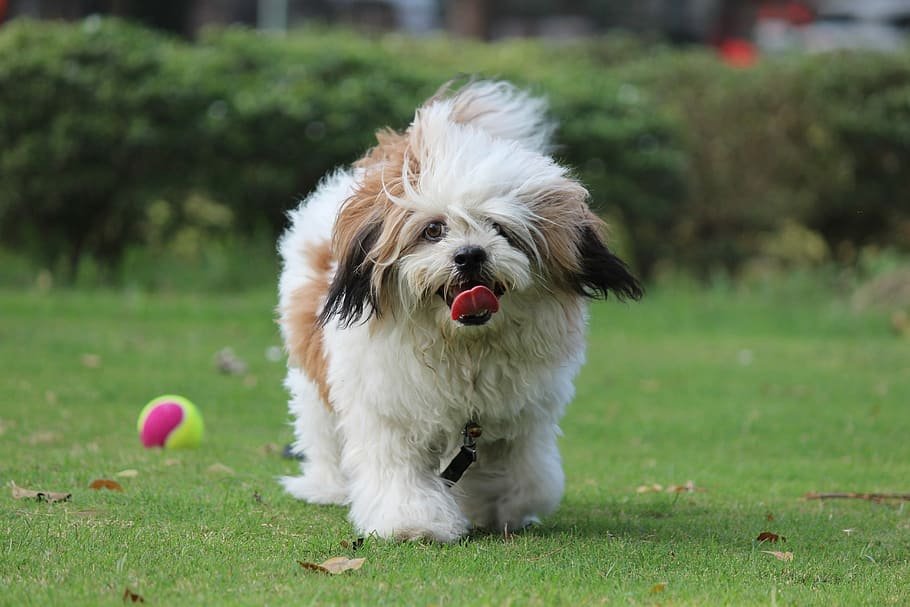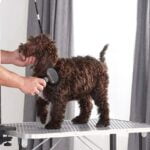Table of Contents
Lhasa Apsos are known for their beautiful, long, and flowing coats, which require regular grooming to keep them looking their best. Proper grooming is essential for maintaining their coat’s health and preventing matting. This grooming requirements for Lhasa Apsos guide covers seven essential tips to help you keep your Lhasa Apso’s coat healthy and beautiful.

Top Tips for Grooming Lhasa Apsos
1. Regular Brushing
Brushing your Lhasa Apso’s coat regularly is crucial to prevent mats and tangles. Aim to brush their coat at least three to four times a week, using a pin brush and a comb to reach the undercoat. Regular brushing keeps the coat smooth and distributes natural oils. For more on brushing techniques, visit AKC Grooming Tips.
2. Bathing
Bathe your Lhasa Apso every three to four weeks, or as needed, using a mild dog shampoo. Make sure to rinse thoroughly to remove all shampoo residue, as any remaining can irritate the skin. After bathing, dry the coat completely to prevent moisture-related skin issues. For bathing guidelines, see The Spruce Pets Bathing Guide.
3. Trimming the Coat
Regular trimming helps maintain the length of your Lhasa Apso’s coat and keeps it looking neat. Focus on trimming around the eyes, ears, and paws to prevent hair from obstructing vision and causing discomfort. You may also consider a professional grooming session every six to eight weeks. For trimming advice, visit PetMD Trimming Guide.
4. Ear Care
Regular ear care is essential to prevent infections. Check your Lhasa Apso’s ears weekly for signs of redness, odor, or discharge. Clean the ears with a vet-recommended ear cleaner and cotton balls. Avoid inserting anything deep into the ear canal. For more on ear care, see AKC Ear Care Tips.
5. Dental Care
Dental hygiene is crucial for preventing periodontal disease and maintaining overall health. Brush your Lhasa Apso’s teeth at least three times a week using dog-specific toothpaste and a soft-bristle toothbrush. Providing dental chews can also help keep their teeth clean. For dental care tips, visit AKC Dog Dental Care.
6. Nail Trimming
Regular nail trimming prevents overgrown nails that can cause discomfort and affect your Lhasa Apso’s gait. Trim the nails every three to four weeks, using a dog nail clipper or grinder. Be cautious to avoid cutting the quick, which can cause bleeding and pain. For nail trimming advice, see The Spruce Pets Nail Trimming.
7. Eye Care
Lhasa Apsos are prone to tear staining. Clean around their eyes daily with a damp cloth or pet-safe eye wipes to remove tear stains and prevent build-up. Regularly check for signs of eye irritation or infection and consult your vet if you notice any issues. For eye care tips, visit PetMD Eye Care.
Conclusion on Grooming Requirements for Lhasa Apsos
Proper grooming is essential for maintaining the health and beauty of your Lhasa Apso’s coat. By following these seven essential tips on grooming requirements for Lhasa Apsos, you can ensure your dog stays clean, comfortable, and looking their best. Regular grooming sessions also provide an excellent opportunity to check for any health issues and bond with your pet. For more advice on pet care, check out our Pet Care Guide.
FAQs on Grooming Requirements for Lhasa Apsos
How often should I brush my Lhasa Apso’s coat?
You should brush your Lhasa Apso’s coat at least three to four times a week to prevent mats and tangles.
What type of shampoo is best for Lhasa Apsos?
Use a mild dog shampoo that is gentle on their skin and coat. Avoid shampoos with harsh chemicals or artificial fragrances.
How do I prevent tear staining in my Lhasa Apso?
Clean around their eyes daily with a damp cloth or pet-safe eye wipes to remove tear stains and prevent build-up.
How often should I trim my Lhasa Apso’s nails?
Trim your Lhasa Apso’s nails every three to four weeks to prevent overgrowth and discomfort.
Is professional grooming necessary for Lhasa Apsos?
While regular at-home grooming is essential, professional grooming every six to eight weeks can help maintain the coat’s length and health.
What should I do if I notice signs of ear infection in my Lhasa Apso?
If you notice redness, odor, or discharge in your Lhasa Apso’s ears, consult your veterinarian for proper diagnosis and treatment.











